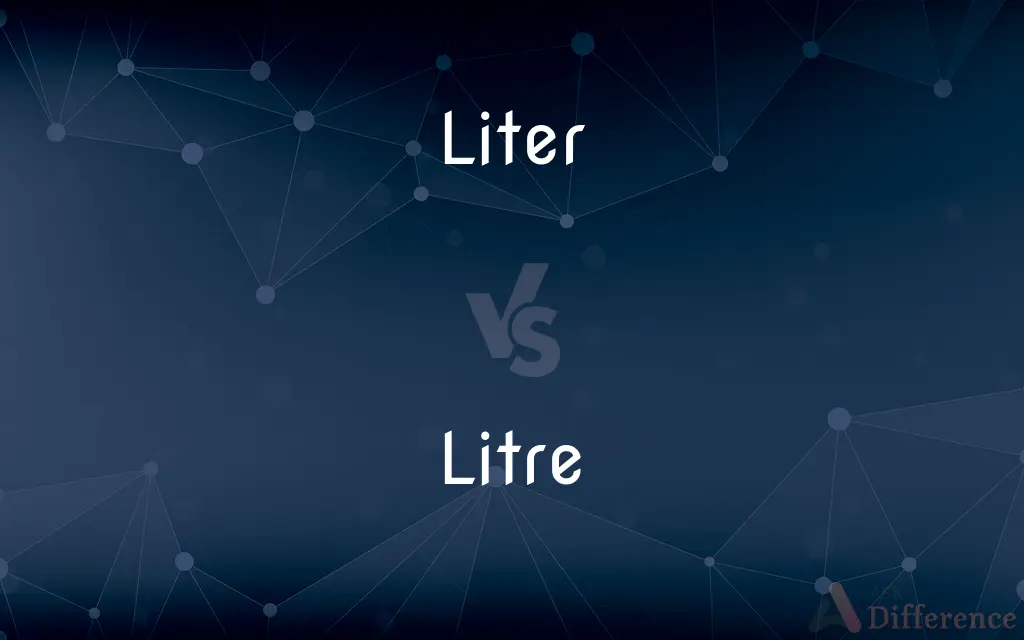Liter vs. Litre — What's the Difference?
By Tayyaba Rehman & Fiza Rafique — Updated on September 8, 2023
"Liter" is the American English spelling for a unit of volume equal to 1,000 cubic centimeters. "Litre" is the British English spelling for the same unit of measurement.

Difference Between Liter and Litre
Table of Contents
ADVERTISEMENT
Key Differences
"Liter" and "Litre" are essentially the same in terms of what they represent—a unit of volume that is part of the metric system, equivalent to 1,000 cubic centimeters. The primary difference between the two is regional; "Liter" is predominantly used in American English, while "Litre" is commonly used in British English and other countries that follow UK spelling conventions.
Both "Liter" and "Litre" have the same conversion rates when it comes to other units of volume. For instance, one liter/litre equals about 0.264172 U.S. gallons. Where the distinction again arises is in academic papers, technical documents, or import/export scenarios. Using "Liter" in a document intended for American audiences and "Litre" for British or Commonwealth readers is advisable for consistency and clarity.
It's not just the spelling of "Liter" and "Litre" that varies; it's also the usage in different computer systems and spell-checkers. American systems default to "Liter," whereas British systems usually suggest "Litre." Both terms are correct as long as they are used in the appropriate context or region.
It's worth noting that "Liter" and "Litre" are also symbols that have standardized abbreviations across the world. In both American and British English, the abbreviation is "L," making it universally recognizable despite the difference in spelling.
Comparison Chart
Spelling
Ends with "er"
Ends with "re"
ADVERTISEMENT
Regional Usage
American English
British English
Abbreviation
L
L
Computer Systems
American default
British default
Documentation
Used in American texts
Used in British texts
Compare with Definitions
Liter
The abbreviation for Liter is "L."
The jug was marked with a maximum capacity of 5L.
Litre
A Litre is a metric unit of volume that is equivalent to 1,000 cubic centimeters.
Could you please buy a litre of milk?
Liter
A Liter is a metric unit of volume equal to 1,000 cubic centimeters.
I bought a two-liter bottle of soda.
Litre
A Litre is equal to about 0.264172 U.S. gallons.
The petrol station sells fuel by the litre.
Liter
"Liter" is used in scientific contexts in the United States.
The lab experiment required 500 milliliters, or half a liter, of solvent.
Litre
"Litre" is commonly used in scientific contexts in the UK.
The UK-based study measured rainfall in litres.
Liter
In American English, "Liter" is the standard spelling for this unit.
The American recipe called for one liter of water.
Litre
The abbreviation for Litre is "L."
The container has a volume of 10L.
Liter
A Liter is equal to about 0.264172 U.S. gallons.
He poured a liter of gasoline into the car.
Litre
In British English, "Litre" is the standard spelling for this unit.
The British recipe called for one litre of water.
Liter
A metric unit of volume equal to approximately 1.056 liquid quarts, 0.908 dry quart, or 0.264 gallon. See Table at measurement.
Litre
The litre (British English spelling) or liter (American English spelling) (SI symbols L and l, other symbol used: ℓ) is a metric unit of volume. It is equal to 1 cubic decimetre (dm3), 1000 cubic centimetres (cm3) or 0.001 cubic metre (m3).
Liter
(American spelling) litre, one cubic decimeter.
Litre
Variant of liter.
Liter
A measure of capacity in the metric system, being a cubic decimeter, equal to 61.022 cubic inches, or 2.113 American pints, or 1.76 English pints.
Litre
The metric unit of fluid measure, equal to one cubic decimetre. Symbols: l, L, ℓ
You should be able to fill four cups with one litre of water.
Liter
A metric unit of capacity equal to the volume of 1 kilogram of pure water at 4 degrees centigrade and 760 mm of mercury (or approximately 1.76 pints)
Litre
(informal) A measure of volume equivalent to a litre.
Litre
Same as Liter.
Litre
A metric unit of capacity equal to the volume of 1 kilogram of pure water at 4 degrees centigrade and 760 mm of mercury (or approximately 1.76 pints)
Common Curiosities
When should I use Litre?
Use "Litre" when writing for a British or Commonwealth audience or following British English conventions.
Are Liter and Litre the same?
Yes, they represent the same unit of volume but differ in spelling based on regional English usage.
Which spelling is older?
Both have the same etymological origin, so neither is older than the other.
What is the abbreviation for both?
The abbreviation is "L" for both Liter and Litre.
Is one more formal than the other?
No, the formality is the same; the difference is in regional usage.
When should I use Liter?
Use "Liter" when writing for an American audience or following American English conventions.
Do both Liter and Litre have the same conversion rates?
Yes, both have the same conversion rates to other units like gallons or cubic meters.
How many cubic centimeters are in a Liter and Litre?
Both are equal to 1,000 cubic centimeters.
How many U.S. gallons are in a Liter or Litre?
Both are equal to about 0.264172 U.S. gallons.
Do spell-checkers differentiate between Liter and Litre?
Yes, American spell-checkers favor "Liter," and British spell-checkers favor "Litre."
Is the spelling interchangeable?
No, the spelling depends on the regional usage and the intended audience.
Which is used in scientific papers?
Both are used, but "Liter" is common in American journals and "Litre" in British journals.
Do both Liter and Litre appear in dictionaries?
Yes, both spellings appear in English dictionaries but are marked for regional usage.
Can I use either spelling in international contexts?
It's best to know your audience, but both are widely understood.
Which one is correct in Canada?
Canada primarily uses "Litre" following British English conventions.
Share Your Discovery

Previous Comparison
Homograft vs. Allograft
Next Comparison
Proof vs. ProveAuthor Spotlight
Written by
Tayyaba RehmanTayyaba Rehman is a distinguished writer, currently serving as a primary contributor to askdifference.com. As a researcher in semantics and etymology, Tayyaba's passion for the complexity of languages and their distinctions has found a perfect home on the platform. Tayyaba delves into the intricacies of language, distinguishing between commonly confused words and phrases, thereby providing clarity for readers worldwide.
Co-written by
Fiza RafiqueFiza Rafique is a skilled content writer at AskDifference.com, where she meticulously refines and enhances written pieces. Drawing from her vast editorial expertise, Fiza ensures clarity, accuracy, and precision in every article. Passionate about language, she continually seeks to elevate the quality of content for readers worldwide.














































